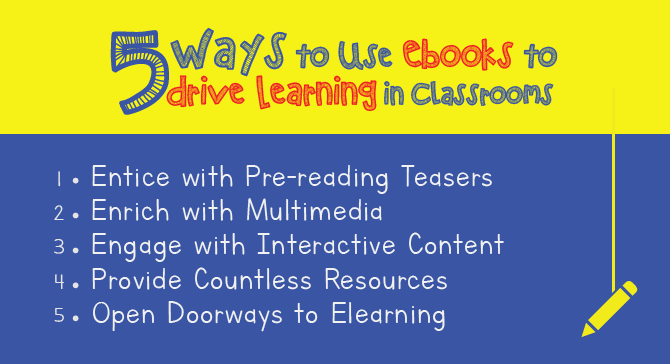5 Ways to Use Ebooks to Drive Learning in Classrooms
With kids’ crazy schedules—soccer practice, violin lessons, and private tutoring—having ebooks on hand at any moment makes that half-hour of downtime between extra-curricular activities productive learning time. Now with ebooks classrooms are more effective.
PTA meetings at one time used to discuss the burden of carrying heavy textbooks, then ebook vs textbook debates ensued for years. Now there’s no denying the advantages of using ebooks. Today we’ll quickly go over the simplest ways ebooks are driving learning in classrooms. In future articles will go in-depth with how ebooks are helping teachers with differentiated learning and how they’re making a difference for students with learning disabilities.
Why does it make sense to use ebooks?
The simplest ebooks are simply a digital version of the actual physical book. They are no more than a PDF or some such. They don’t come with any extra features other than what you get with the platform on which you are reading the ebook. These may include a dictionary to check terms or the capacity to annotate the book or take notes separately.
In other ebooks, there are interactive activities incorporated into the process to check whether the reader has comprehended the material, or whether there has been any improvement in their grammar or vocabulary.
Students favorites though are the media content. These make the experience of reading an app much more enjoyable and helpful than the experience of reading a physical book.
Students will be reading these apps on a smartphone or tablet, or some other kind of smart device. These have various capabilities, like voice recording capabilities, or video recording capabilities. They are also able to support many free apps that can turn what is basically a passive and receptive lesson into something where the student interacts continuously with the book and even engage the creative process to come up with their creations as part of the learning process.
Once students create their own work, they can share them in the form of an email or a blog that is dedicated to classroom activities.
How can ebooks be used to drive learning in the classroom?
Here are five simple ways that teachers are using ebooks to enhance classroom learning and development.
1. Entice with pre-reading teasers.
“Pre-reading tasks play the role of motivating the learner, especially when students are asking ‘Why do I need to learn this?’” says Thomas Wood of Best Essay Tips.
Before you present a topic to any learners, you will need to prove its relevance to their lives and future. Pose questions that intrigue them. Encourage students to do a little research. By the time they are tackling the actual book, they are more prepared to learn.
2. Enrich with multimedia.
Ebooks don’t just include text. They often include other forms of media that you wouldn’t find in a print book: audio, video, and 3D models.
Foreign languages come to life as students hear the strange new words and sentences pronounced naturally. Stories of historic events enter our world and imagination with videos. Science labs become more tangible when 3D models are available for students to explore.
Media enriches lessons and imagination for students and teachers alike.
3. Engage with Interactive Content
While a print book is passive and depends on the memory of the student alone, an ebook is interactive and pulls readers into interactive games, questions, and even online discussions, enticing students to engage with the ebook.
Kinesthetic learners no longer feel alienated by dull passive-learning books.
4. Provide Countless Resources
Expand the resources you make available for your students. With a simple phone, tablet, or e-reader, a student can carry the equivalent of an entire library in the palm of their hands, which means they have access to a lot more material than they would have otherwise. Teachers can curate the lists of recommended readings and with so many free school ebooks, students become independent self-learners.
5. Open Doorways to Elearning
Ebooks are only one kind of digital technology among many out there, and they help to introduce the students to the wonderful world of digital learning. Students can begin blogging, vlogging, creating their own ebooks or event their own apps. Sharing and collaborative platforms facilitate discussions and often form a launching pad for students to begin student-initiated and driven projects.

Conclusion
With the variety of interactive content in ebooks, learning becomes easier for all types of learners: auditory, visual, kinesthetic and even tactile learners. Ebooks are the future of the classroom, alongside many other kinds of digital technology. While physical reading materials will always have their allure, ebooks add a new and revolutionary dimension that your students will definitely come to enjoy. It will also make your life easier as a teacher.
Read these posts.
The Amazing World of Elearning [Infographic]
Ebook and LMS Integration using LTI
Interactive Journals for Students: How to Create and Use Them Effectively









